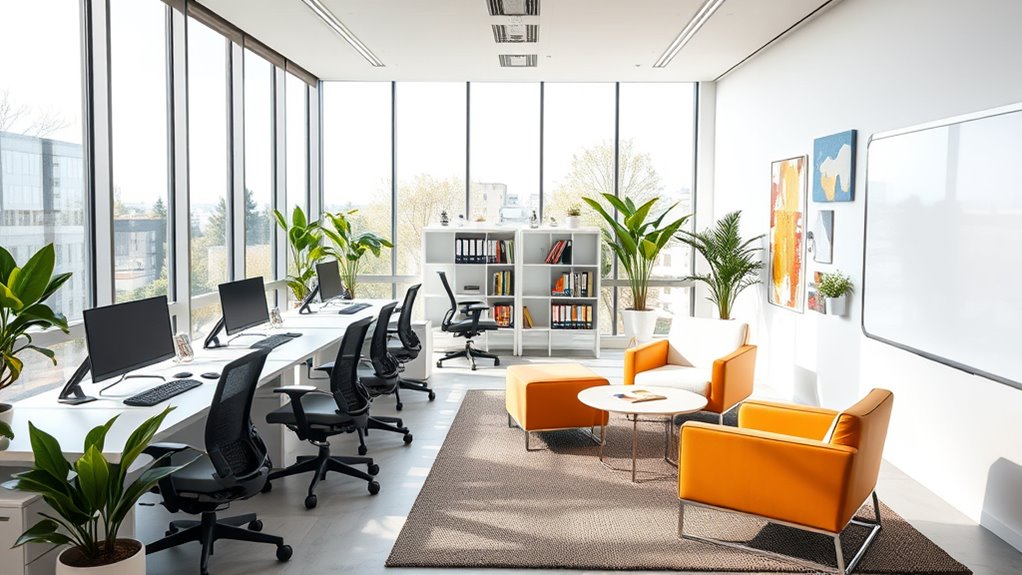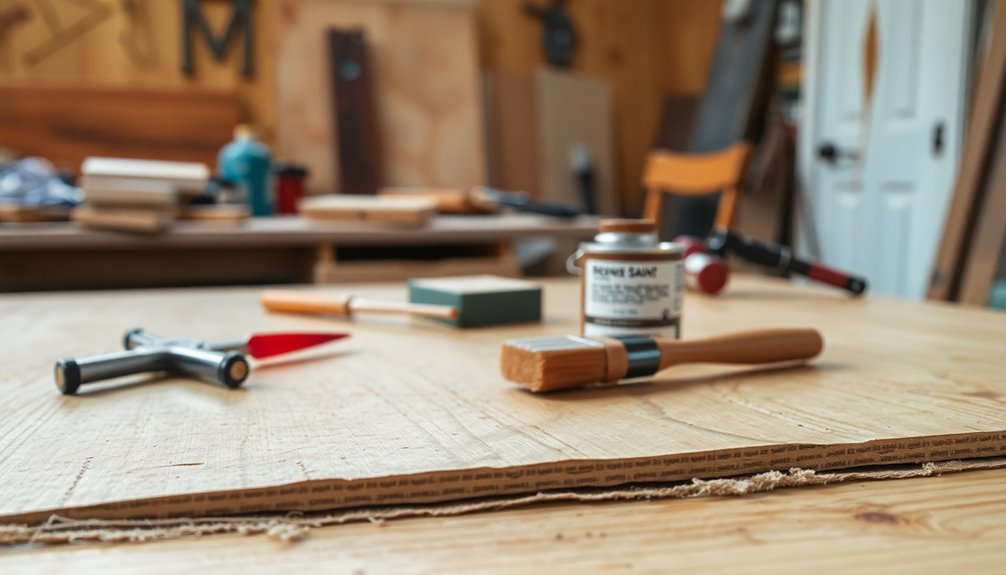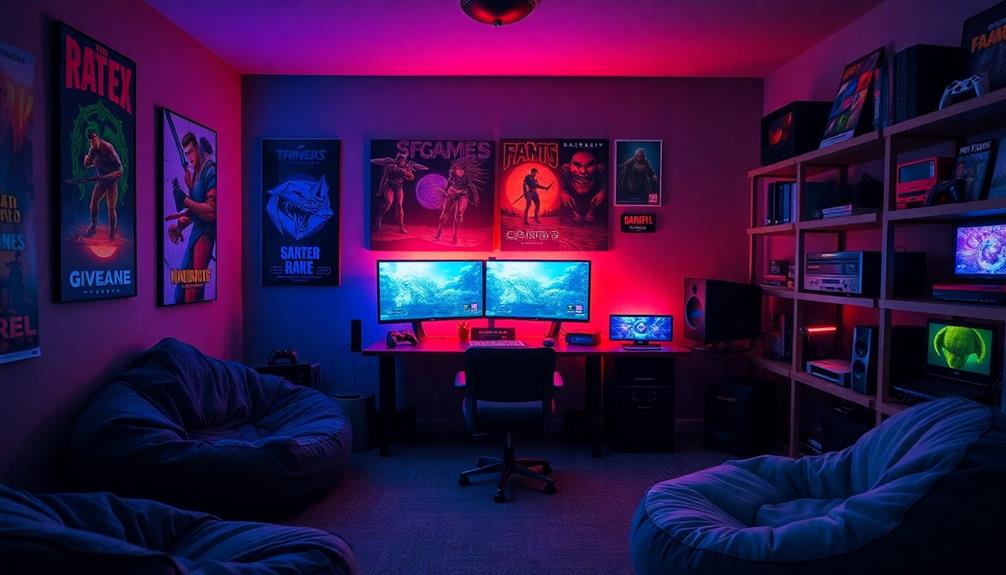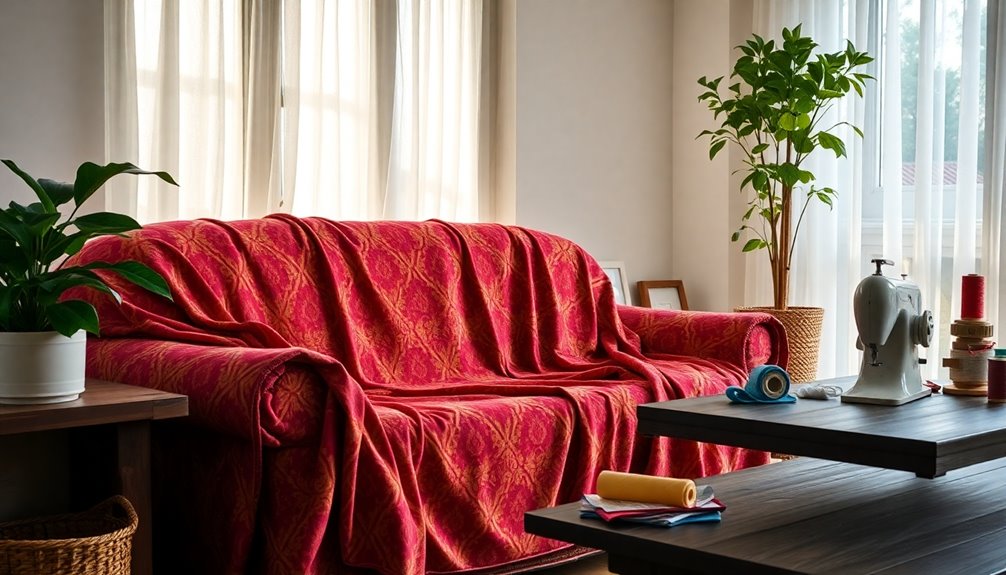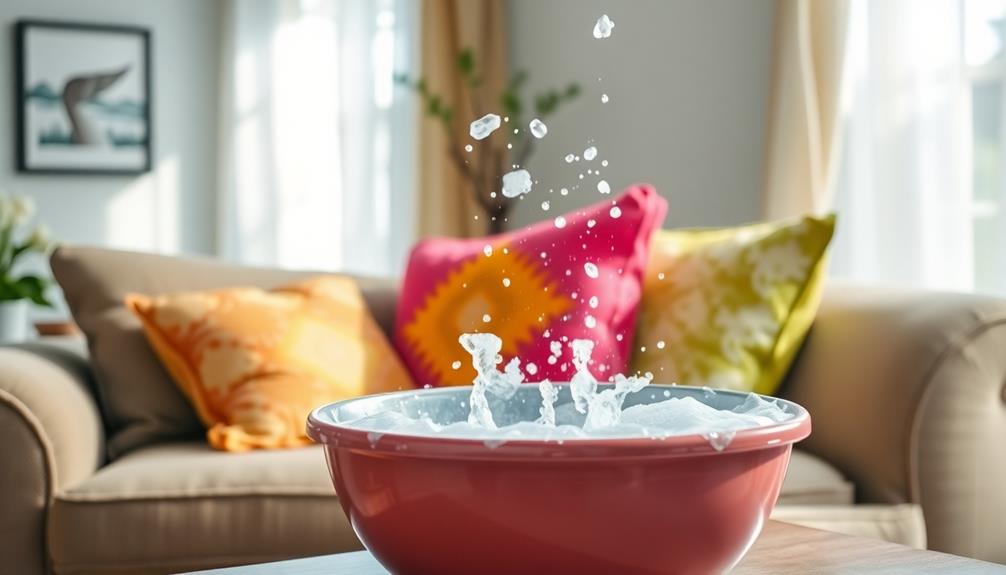To create a productive work environment, start by evaluating your current space and identifying what needs improvement. Plan a flexible layout with ergonomic furniture and strategic zones for collaboration and focus. Use energizing and calming colors, maximize natural and adjustable lighting, and integrate technology for efficiency. Keep your space organized with smart storage, personalize it, and regularly update your setup. If you keep exploring, you’ll discover how to transform your office into a motivating and efficient workspace.
Key Takeaways
- Conduct thorough workspace assessments to identify needs, bottlenecks, and environmental factors affecting productivity.
- Integrate ergonomic furniture and flexible layouts to enhance comfort and support diverse work styles.
- Use color psychology and natural lighting to create energizing and calming environments tailored to task requirements.
- Personalize workspaces with meaningful decor and leverage technology for automation and streamlined workflows.
- Optimize space with designated zones, efficient storage, and regular maintenance to ensure a clean, functional, and adaptable office.
Assessing Your Current Workspace and Identifying Needs
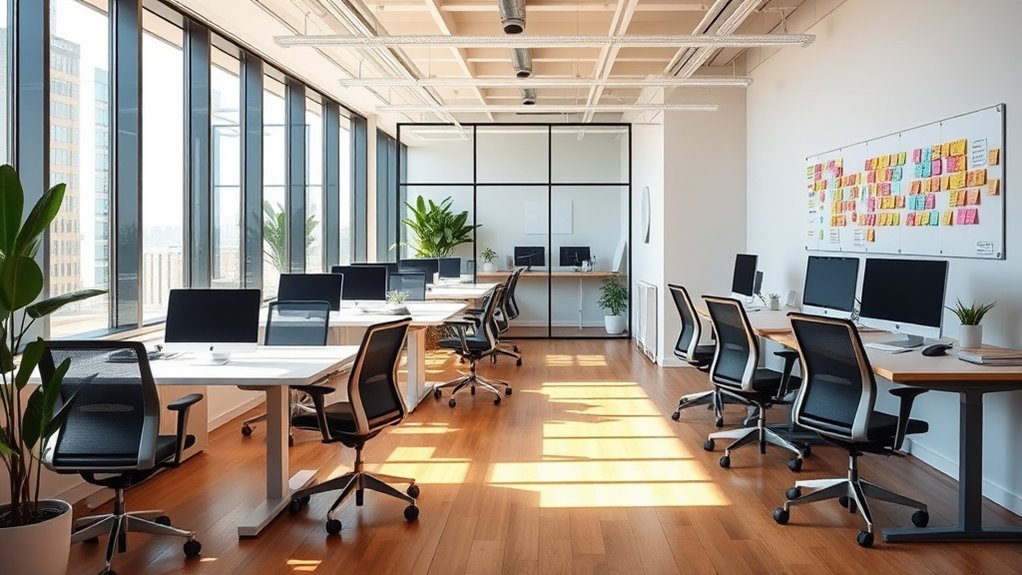
Before beginning your office space makeover, it’s essential to evaluate your current workspace thoroughly. Walk through your office and note what works well and what doesn’t. Consider how your space supports your daily tasks and team collaboration. Are your desks arranged efficiently? Do you have enough storage, or is clutter a problem? Pay attention to lighting, noise levels, and overall comfort. Talk to your team to understand their needs and frustrations. Identify any bottlenecks or areas that hinder productivity. Assess your technology setup—are your devices up-to-date and functioning properly? By honestly analyzing these aspects, you’ll gather valuable insights. This foundation helps you pinpoint specific improvements, ensuring your renovation creates a workspace that boosts efficiency, comfort, and morale. Also, evaluating your support hours and environment can help you plan for optimal working conditions, and considering your workplace culture can ensure the redesign enhances collaboration and employee satisfaction. Incorporating insights from best vacuum evaluations can help you select equipment that maintains a clean and healthy environment, further supporting productivity. Additionally, reviewing ergonomic furniture options can improve comfort and reduce fatigue for you and your team. Moreover, understanding the principles of sound healing science can inspire ways to create a calmer, more focused atmosphere within your workspace.
Planning an Efficient and Flexible Layout
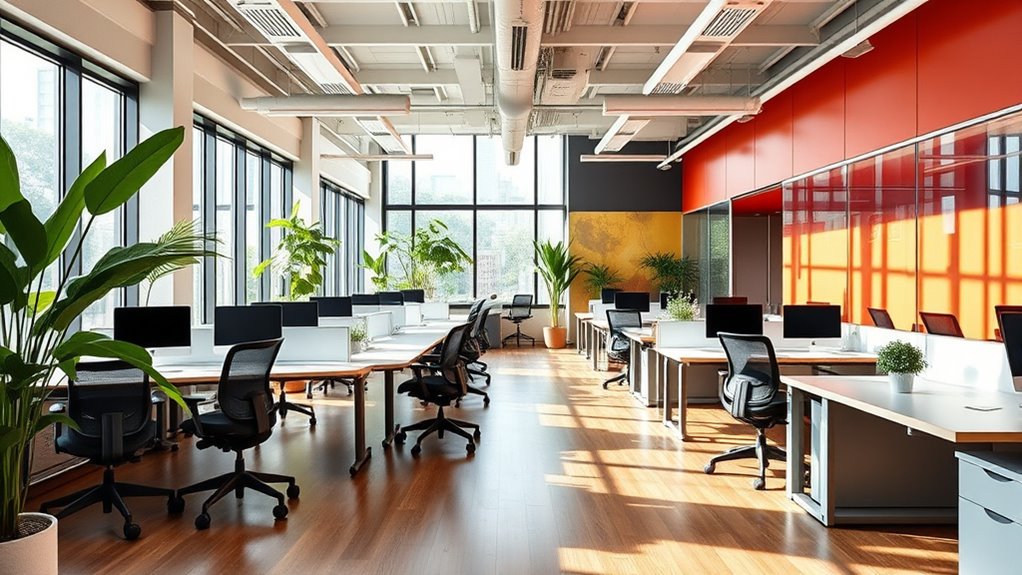
Designing an efficient and flexible office layout requires thoughtful planning to accommodate both current needs and future growth. Start by analyzing your workflows and determining which areas need dedicated spaces, like collaboration zones and quiet workstations. Use open-plan designs to foster communication, but include private areas for focused tasks. Consider modular furniture that can be easily reconfigured as your team evolves. Incorporate zones for different activities, ensuring each space serves its purpose without overcrowding. Flexibility also means planning for technology needs, with accessible power outlets and adaptable setups. By thoughtfully balancing open and private spaces, you create an environment that supports productivity today and scales efficiently tomorrow. Implementing space optimization strategies can further enhance organization and adaptability in your office environment. Additionally, regularly reviewing and adjusting your layout helps maintain efficiency as your team’s needs change. Incorporating ergonomic furniture can also contribute to employee well-being and overall productivity. Understanding aura dynamics can even inspire innovative design elements that promote positive energy flow throughout the workspace.
Incorporating Ergonomic Furniture for Comfort and Health
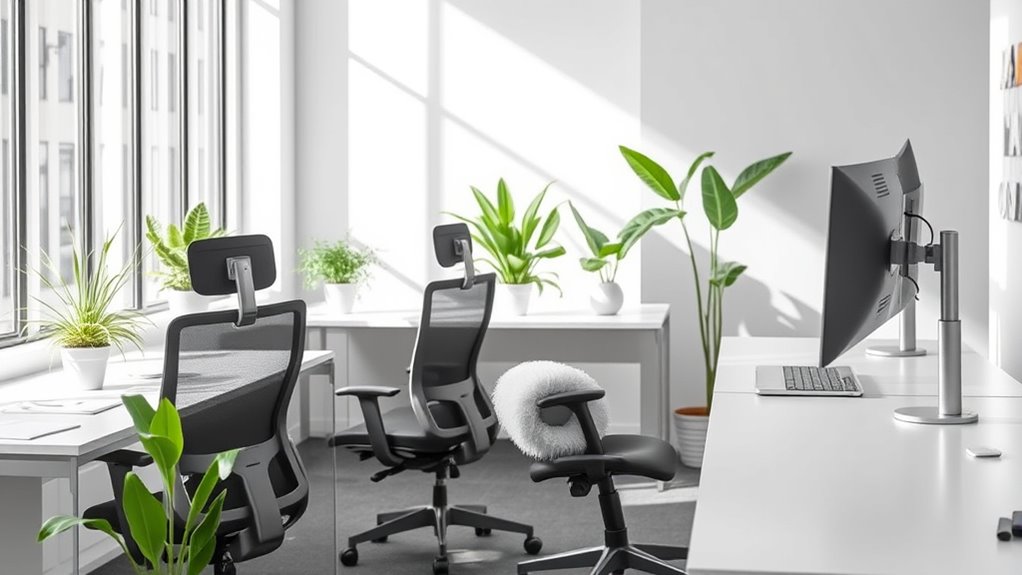
Incorporating ergonomic furniture into your office space is essential for supporting your team’s comfort and long-term health. When choosing desks, chairs, and accessories, prioritize adjustable features that allow each person to customize their setup. Ergonomic chairs with lumbar support reduce back strain, while height-adjustable desks promote better posture and movement throughout the day. Consider keyboard trays and monitor stands to keep screens at eye level, preventing neck and eye strain. Using ergonomic furniture not only enhances comfort but also boosts productivity by reducing discomfort and fatigue. Investing in quality, supportive pieces creates a healthier work environment, encouraging your team to stay focused and energized. Remember, small adjustments can make a significant difference in your office’s overall comfort and well-being.
Choosing a Color Palette to Boost Productivity and Mood
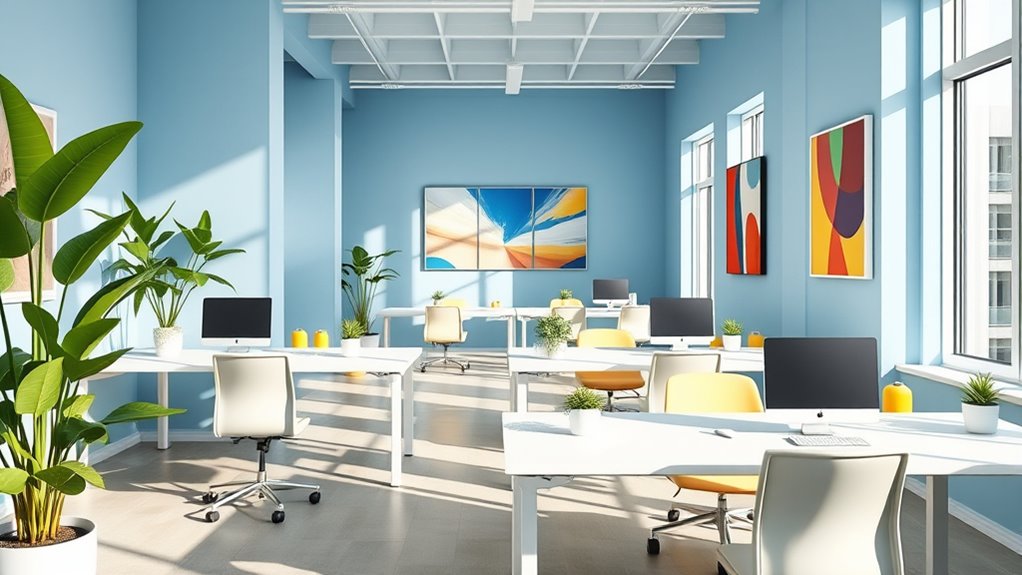
Choosing the right colors can substantially impact your mood and productivity at work. Bright, energizing tones like yellows and oranges can boost focus, while calming shades like blues and greens create a relaxed atmosphere. By harmonizing your office tones, you can create a space that fosters both motivation and well-being. Additionally, selecting colors thoughtfully can help prevent distractions and create a cohesive environment that supports your overall office space design. Incorporating a color palette tailored to your work style can enhance your overall efficiency and satisfaction in your workspace. Understanding how different color psychology effects mood can further refine your choices. Recognizing signs of a checked-out partner can also influence how you design shared spaces to promote engagement and connection. Being aware of environmental cues can help you optimize your workspace for better focus and comfort.
Color Psychology Effects
The colors you select for your office can considerably influence your mood and productivity throughout the day. Different hues evoke specific psychological responses that can enhance focus, creativity, or calmness. For example, blue promotes a sense of tranquility and helps improve concentration, making it ideal for tasks requiring deep focus. Green offers a calming effect and reduces eye strain, fostering balance and renewal. Red energizes and stimulates action, suitable for dynamic work environments, but too much can cause agitation. Yellow inspires optimism and creativity, perfect for brainstorming areas. Understanding these effects allows you to choose a color palette that aligns with your work style and desired atmosphere, helping you stay motivated and productive. Additionally, incorporating elements of ethical hacking principles such as security awareness can foster a mindset of vigilance and proactive problem-solving in your workspace. Selecting the right color psychology strategies can further enhance your environment by influencing subconscious perceptions and behaviors. For instance, certain colors can also subtly signal security and professionalism, reinforcing a safe and trustworthy atmosphere. Carefully selected colors can transform your office into a space that supports your best performance.
Harmonizing Office Tones
Selecting the right combination of office tones creates a harmonious environment that enhances both mood and productivity. You should choose colors that align with your work goals and personal preferences, creating a balanced atmosphere. For example, blues and greens promote calmness and focus, ideal for detailed tasks. Bright yellows energize creativity and optimism but should be used sparingly to avoid overstimulation. Neutrals like beige and gray provide a versatile backdrop that keeps distractions minimal. When harmonizing tones, consider the natural lighting and the function of each space. Consistent color schemes across your office foster a sense of cohesion, reducing visual clutter. Additionally, integrating color psychology principles can help you select hues that support specific work activities. Ultimately, your color palette should reflect your brand identity while supporting your team’s emotional well-being and efficiency.
Optimizing Lighting for Focus and Well-Being
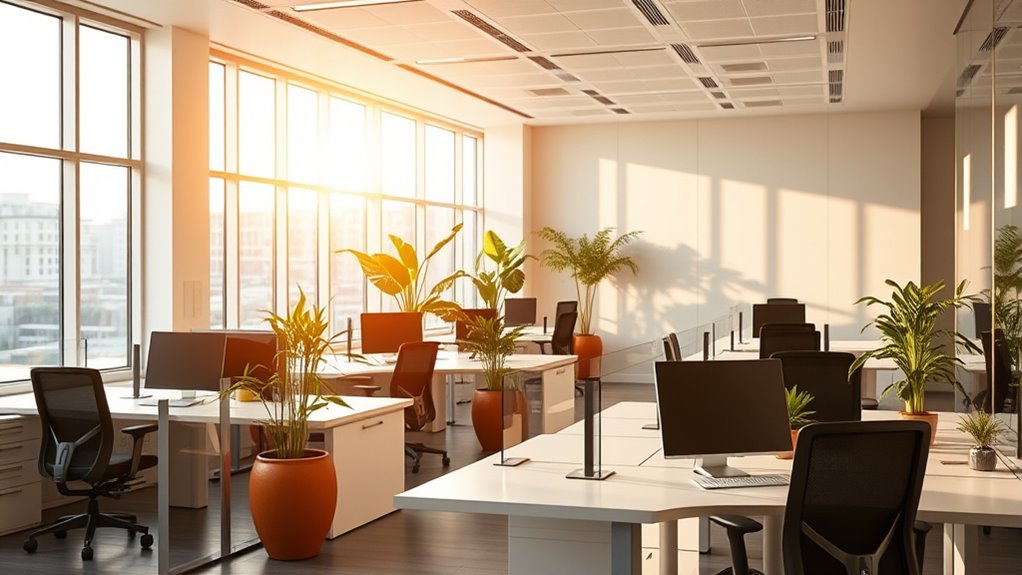
Good lighting can notably boost your focus and overall well-being in the office. Natural light offers numerous benefits, but you also have artificial options to contemplate for consistent illumination. When you optimize your lighting setup, you create an environment that enhances productivity and supports your health. Incorporating adaptive lighting technologies can further personalize your workspace to match your needs throughout the day. Additionally, selecting lighting with appropriate brightness levels and color temperatures can help reduce eye strain and improve alertness. Considering the breed’s personality can also guide you in selecting the right lighting ambiance to keep your workspace energizing and comfortable. Regularly adjusting your lighting can also help in maintaining optimal skin health, as proper illumination can reduce eye fatigue and stress. Being mindful of spiritual insights related to positivity and emotional balance can also influence the atmosphere you create in your office.
Natural Light Benefits
Natural light plays a crucial role in enhancing your workspace by boosting your mood and energy levels. When you let sunlight flood your office, you activate your body’s natural circadian rhythms, improving alertness and reducing fatigue. Exposure to daylight can also increase productivity and creativity, making tasks feel less tedious. To maximize these benefits, position your desk near windows or use transparent partitions that let light pass through. Incorporating self-watering plant pots can also help maintain a healthy and lively environment with minimal effort.
Artificial Lighting Options
While natural light substantially benefits your workspace, there are times when artificial lighting becomes necessary to maintain consistent focus and well-being. To achieve this, choose LED bulbs with adjustable brightness and color temperature. Warm light creates a cozy atmosphere, while cooler tones boost alertness and concentration. Consider task lighting, such as desk lamps, to target specific areas without illuminating the entire room excessively. Avoid harsh, flickering lights that can cause eye strain or fatigue. Dimmable fixtures give you control over lighting levels throughout the day. Additionally, installing indirect lighting options, like wall sconces or ceiling fixtures, reduces glare and creates a balanced, comfortable environment. Proper artificial lighting supports your productivity, mood, and overall health during long work hours. Incorporating lighting design principles and understanding lighting types can further enhance the effectiveness of your workspace lighting setup. Regularly maintaining and filtering your lighting ensures consistent performance and a healthy environment.
Lighting and Productivity
Effective lighting directly influences your ability to focus and maintain well-being throughout the workday. Bright, natural light helps boost your mood and reduces fatigue, keeping you alert and engaged. Position your desk near windows to maximize daylight exposure, but avoid glare on your screen. Use layered lighting—combine overhead lights with task lamps—to create a balanced environment that minimizes eye strain. Adjust color temperature to mimic natural daylight; cooler tones increase alertness, while warmer tones promote relaxation during breaks. Proper lighting also reduces headaches and improves concentration. Regularly evaluate your lighting setup, making changes as needed to ensure it supports your productivity and well-being. When lighting feels right, you’ll notice improved focus, energy, and overall comfort during your work hours.
Adding Personalization and Creative Touches
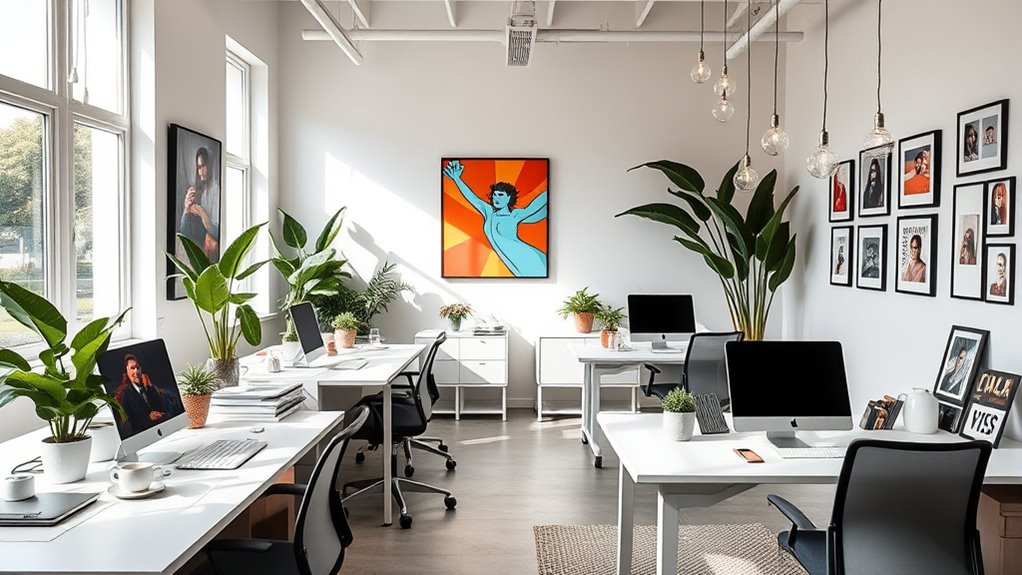
Adding personal touches to your office space instantly makes it feel more inviting and unique. When you incorporate elements that reflect your personality, you create a workspace that motivates and inspires you daily. Consider displaying photos of loved ones or memorable trips to evoke positive feelings. You can also add creative touches like artwork, motivational quotes, or colorful accessories to energize the environment. Personalization doesn’t have to be extravagant; simple updates can make a significant difference. These touches boost your mood and help establish a space where you feel comfortable and focused. Keep in mind, the goal is to make your workspace a reflection of you while maintaining a professional vibe. Small, thoughtful details can transform your office into a space you genuinely enjoy.
Integrating Technology for Seamless Workflow
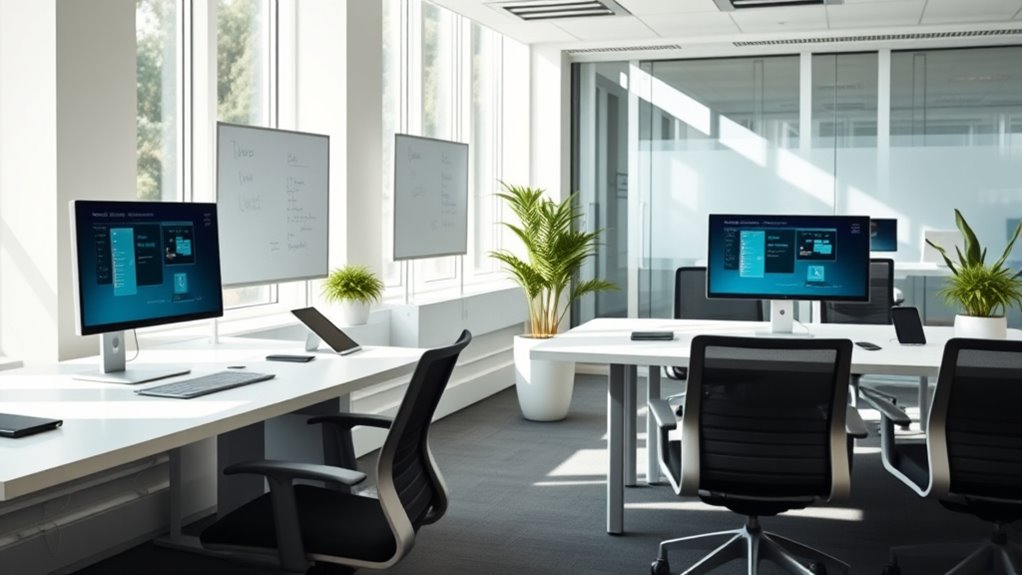
Integrating smart devices, cloud storage, and automation tools can transform how you work daily. These technologies help streamline tasks, improve collaboration, and boost productivity. By adopting them, you create a more efficient and connected office environment.
Smart Device Integration
To create a seamless workflow in your office space, connecting smart devices is essential. When your devices work together, you save time and reduce disruptions. Start by integrating smart assistants like voice-activated speakers to control lighting, temperature, and other devices effortlessly. Use smart plugs to automate common equipment, turning them on or off with schedules or voice commands. Additionally, install wireless charging stations to keep devices powered without cluttering desks.
- Streamline communication with smart intercom systems
- Automate lighting and climate control for efficiency
- Use sensor-based devices to monitor workspace conditions
Cloud Storage Solutions
Cloud storage solutions have become essential for creating a seamless workflow in your office by enabling quick and secure access to files from anywhere. With cloud storage, you can effortlessly share documents with colleagues, reducing delays and improving collaboration. It eliminates the need for physical servers or external drives, lowering maintenance costs and minimizing data loss risks. You’ll enjoy real-time updates, ensuring everyone works with the latest version of a file. Plus, most solutions offer strong encryption and access controls, so your sensitive data stays protected. Setting up a cloud storage system is straightforward, and many providers integrate smoothly with your existing tools. Overall, adopting cloud storage boosts efficiency, flexibility, and security—cornerstones of a productive, modern workspace.
Automation Tools Adoption
By adopting automation tools, you can streamline repetitive tasks and free up valuable time for more strategic work. Automation reduces manual effort, minimizes errors, and boosts overall efficiency in your workspace. With the right tools, scheduling meetings, managing emails, and tracking project deadlines become seamless processes. This allows you to focus on high-impact activities that drive your business forward. To get started, consider implementing solutions like:
- Workflow automation platforms (e.g., Zapier, Automate.io)
- Task management apps (e.g., Asana, Trello)
- Communication tools with automation features (e.g., Slack bots, email responders)
These tools integrate smoothly into your existing systems, transforming your office into a more productive environment. Embracing automation helps you stay organized, responsive, and ahead of deadlines.
Creating Collaborative and Quiet Zones
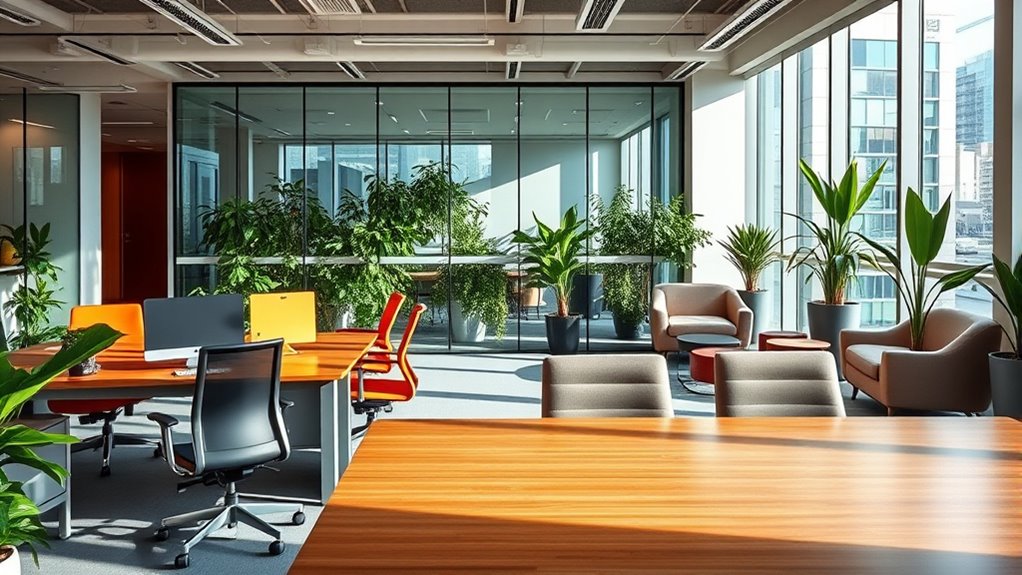
Designing your office space to include both collaborative and quiet zones can considerably boost productivity and employee satisfaction. By creating designated areas for teamwork, you enable spontaneous interactions and idea sharing, fostering innovation. Use open layouts with flexible furniture, such as modular tables and comfortable seating, to support collaboration. For quiet zones, consider soundproof booths or rooms where employees can focus without distractions. Position these spaces strategically—away from high-traffic areas—to minimize noise. Clearly mark each zone with signage or signals so employees know where to gather or retreat for concentration. Balance is key; providing varied spaces shows that you value both teamwork and individual focus, helping your team work efficiently and feel more engaged.
Implementing Storage Solutions to Reduce Clutter
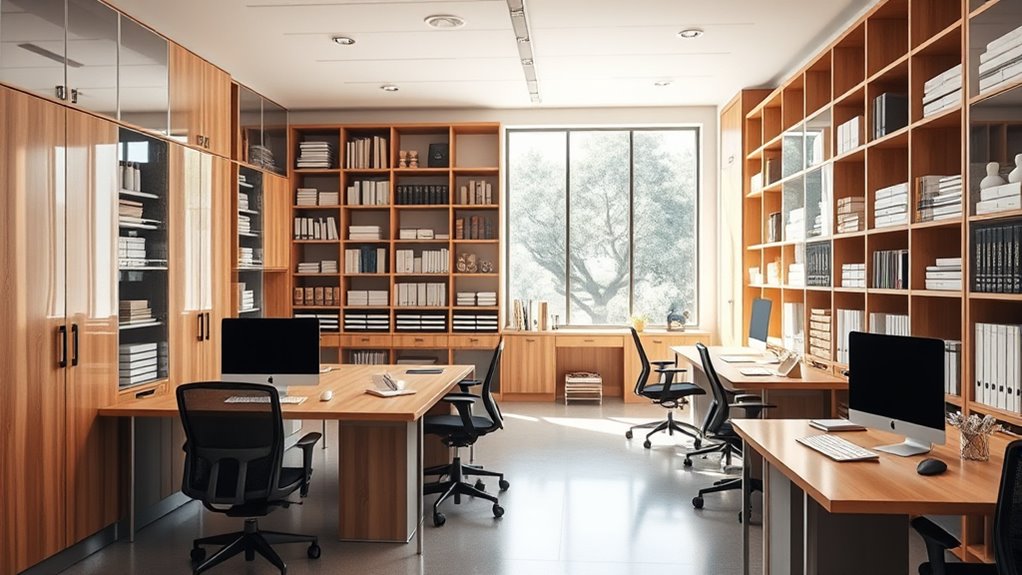
Effective storage solutions play a pivotal role in maintaining an organized office environment, especially when balancing collaborative and quiet zones. Proper storage keeps clutter out of sight, helping you stay focused and efficient. To maximize space, consider vertical storage options like wall-mounted shelves or filing cabinets that free up valuable floor space. Incorporate multi-functional furniture, such as desks with built-in drawers or storage ottomans, to keep essentials close yet out of view. Labeling systems make retrieving items quick and easy, reducing the time spent searching. Additionally, designate specific storage zones for different materials, so everything has a place. These strategies streamline your workflow, reduce distractions, and create a clean, professional atmosphere that promotes productivity.
Maintaining and Evolving Your Office Environment
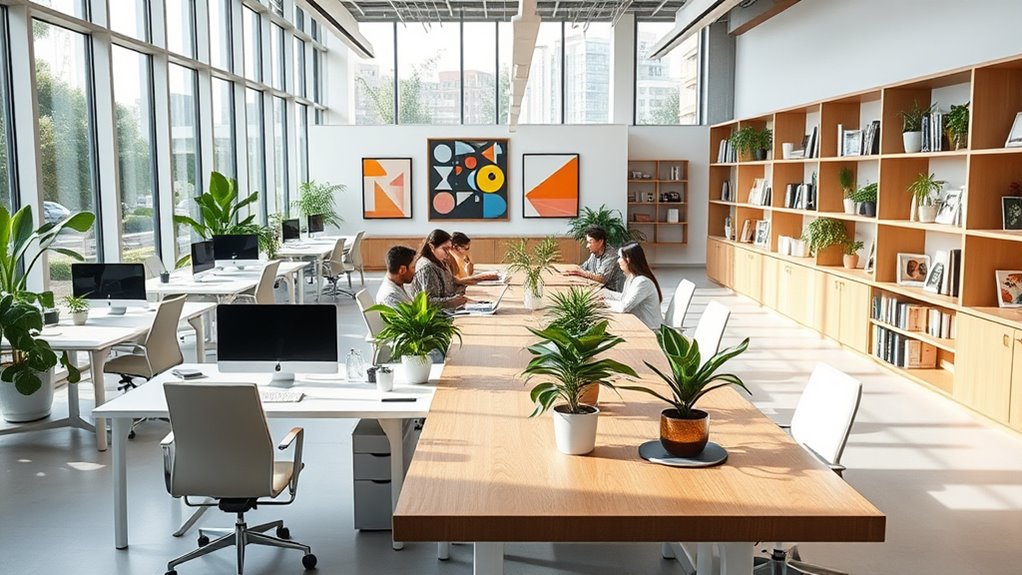
Maintaining and evolving your office environment requires ongoing attention to guarantee it remains functional and inspiring. Regularly assess your space to identify areas needing improvement or updates. Keep your workspace clean and organized to promote productivity and reduce stress. Solicit feedback from your team to understand their needs and preferences, making adjustments accordingly. Stay current with new ergonomic standards, technologies, and design trends that can enhance comfort and efficiency. Periodically refresh decor or reconfigure layouts to prevent stagnation and boost creativity. Prioritize flexibility so your office can adapt to changing team sizes or workflows. By actively managing your environment, you assure it continues to support your goals and remains a motivating, comfortable space for everyone.
Frequently Asked Questions
How Can I Incorporate Biophilic Design Into My Office?
You can incorporate biophilic design into your office by adding natural elements like plants, which boost air quality and reduce stress. Use natural light as much as possible, and incorporate organic shapes and materials such as wood or stone. Create views of outdoor scenery from windows, and consider green walls or indoor gardens. These touches help foster a calming, inspiring atmosphere that enhances productivity and well-being.
What Budget-Friendly Tips Are Available for Office Makeovers?
Imagine transforming your dull workspace into a vibrant hub without breaking the bank. You can start by repainting walls with fresh, bright colors, adding inexpensive plants for a touch of nature, or rearranging furniture to optimize flow. Use DIY decor projects or thrift store finds to personalize your space. Small changes like these brighten your environment, boost morale, and improve productivity—all while staying budget-friendly and easy to implement.
How Do I Select Technology That Adapts to Future Needs?
When selecting technology that adapts to future needs, you should prioritize flexibility and scalability. Look for solutions that can easily integrate with new systems and upgrade without major overhauls. Choose cloud-based options for remote access and expansion. Stay informed about emerging trends and invest in versatile tools that can grow with your business. Regularly review your tech needs to guarantee your investments remain relevant and adaptable over time.
What Are Effective Ways to Soundproof a Busy Workspace?
Imagine a bustling hive of activity, yet you crave quiet moments to focus. To soundproof your workspace, you can add thick curtains or acoustic panels that absorb noise like a sponge. Plants with dense leaves also act as natural sound barriers. Sealing gaps around doors and windows prevents sound leaks. Using rugs and upholstered furniture further dampens echoes, creating a calmer environment where focus thrives despite the busy surroundings.
How Can I Encourage Employee Input in Office Redesign?
Encouraging employee input in office redesign starts with creating an open environment where everyone feels comfortable sharing ideas. You can hold brainstorming sessions, send out surveys, or set up suggestion boxes. Actively listen to their feedback and show appreciation for their contributions. Involving employees in decision-making not only boosts morale but also guarantees the space truly meets their needs, leading to a more productive and engaging workplace.
Conclusion
A well-designed workspace can boost productivity by up to 25%, transforming how you work daily. By evaluating your needs, optimizing layout, and incorporating ergonomic furniture, you create an environment that supports focus and well-being. Remember, a flexible and clutter-free office fosters creativity and reduces stress. Keep evolving your space to stay aligned with your goals. Investing in your office isn’t just aesthetic—it’s a smart move for your overall success.
